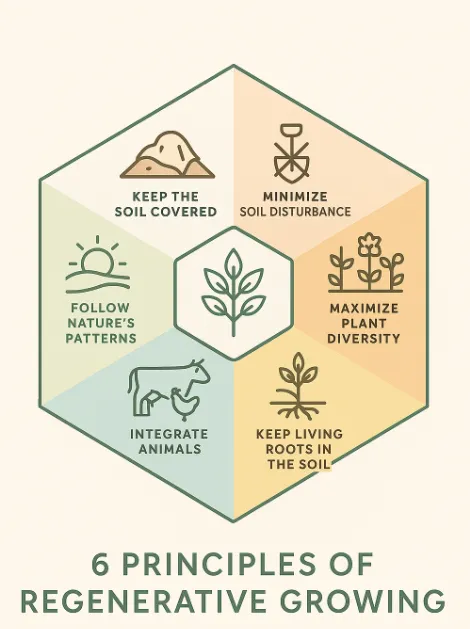
The 6 Principles of Regenerative Growing
Go beyond sustainability. Discover the six regenerative growing principles that rebuild soil, support biodiversity, and create abundant, life-giving farms. Because your soil deserves more than “meh.”
1. Keep the Soil Covered
Bare soil is sad soil.
Mulch, cover crops, or low-growing plants protect against erosion, retain moisture, and feed your microbe army.
👉 Think: compost blankets, living mulch, shredded leaves, and no more naked soil.
2. Minimize Soil Disturbance
Tilling is like an earthquake for your underground ecosystem.
Low-till or no-till keeps the fungal networks intact and worms happy.
🙌 Bonus: less weeding, fewer blisters, and more soil structure.
3. Maximize Plant Diversity
Monocultures are pest buffets.
A mix of herbs, vegetables, flowers, shrubs, and trees? That’s biodiversity with benefits.
🌀 Translation: the more variety, the fewer problems.
4. Keep Living Roots in the Soil
Dead zones = microbe sadness.
Even in winter, cover crops and perennials keep feeding soil life under the surface.
🌾 Cover crops are your off-season MVPs.
5. Integrate Animals
From chickens to composting worms, animals create movement, fertility, and life.
🐓 Pro tip: rotate grazing, manage timing, and let animals be ecosystem engineers.
6. Follow Nature’s Patterns
Stop forcing it.
Forests and prairies don’t need spreadsheets. Nature thrives through cycles and interdependence.
🌿 Observe. Adapt. Collaborate instead of control.
Checklist: Want this as a printable checklist with icons for your farm crew, school garden, or homeschool binder?
Wanna Geek Out?
• Soil Health Principles – USDA NRCS
• Rodale Institute on Regenerative Organic Agriculture
• Kiss the Ground Documentary (Netflix)
• Why Regenerative? – Regeneration International
© 2025 Clemson Tea Farm. All rights reserved.
www.clemsonteafarm.com/medicaldisclaimers
